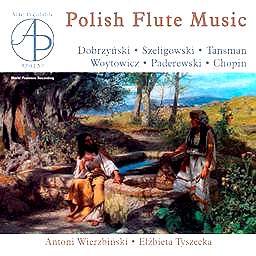Poland, lately, has
made impressive strides in the classical
recordings field, and Acte Préalable
has done an admirable job in spotlighting
both Polish composers and Polish artists.
It does so again in this release. Acte
Préalableís catalogue has quite
a few world premiere recordings and,
though this disc makes no such claim,
Iíve not been able to find other recordings
currently available for most of the
pieces on this disc.
The first piece here
presented is by Dobrzynski, who has
some rather Beethovenian string quintets
available on this same label. Based
primarily in Warsaw, he composed chamber
and piano music primarily, though he
has a symphony, an opera, and various
songs to his credit. This piece has
the overarching atmosphere of Weber.
Regarding recording aesthetic, the piano
if played on its own would seem a poor
instrument, but in its pairing with
the flute, fits well. The Andante opens
rather pensively, but with some scales
in major mode that keep things from
getting too earnest. The Rondo is more
of a success, with an enjoyable bounce
and some rapid passagework. There isnít
much surprising in the piece, but it
is a pleasant listen.
Following the Romantic
Dobrzynski is the far more modern-sounding
Szeligowski, a Boulanger student. Listening
to the piece, one can easily hear the
influence of Prokofiev and Stravinsky.
The flute sonata of 1952 shows itself
as a rather balanced work, with equal
weight given to both instrumentalists.
Considering the composerís general focus
on solo piano works, the music is relatively
reserved regarding any sympathy for
the piano, an element that Alexander
Tcherepnin had difficulty overcoming
with the sonatas he wrote, the cello
sonatas in particular. The final movement
of the Szeligowski is a frantic chase
between the piano and flute, with syncopated
elements requiring a tight ensemble.
What follows is the
Sonatine á Lois Fleury pour
flute et piano by Aleksander Tansman,
who has been seeing an increasing number
of works being recorded since his death
in 1986. This includes the suite for
two pianos reviewed earlier on this
website (review)
Born
in Łodź in 1897, he, of the
Polish composers Iíve heard thus far,
best fits the Jazz Age in which he lived.
The opening theme is Oriental in character,
which the liner notes also mention,
but combined with the piano part also
fits the Twenties, with the rolling
wheels of city busy-ness. After a brief
Intermezzo, the Fox Trot continues the
feel of contemporary popular music.
Tansman, as the liner notes indicate,
had a soft spot for what is now called
"light music". Of the pieces
in this collection, this stands out
as the lightest effort, but with its
occasional shimmy, is well worth a listen.
Bolesŀaw Woytowicz,
whose piano music is represented on
a different Acte Préalable release
(AP0082) was born in present day Ukraine
and spent most of the productive years
of his life in Katowice. As a professor
at the Katowice Academy of Music, he
composed until his death. There are
three symphonies, cantatas, string quartets
and chamber music, much of which relies
upon classical forms and structures.
The flute and piano sonata of 1952 has
the general feel of Hindemith, with
a focus on counterpoint and an uneasy
feel to the harmonies. The second theme
of the first movement is a languid beauty.
Those familiar with Satieís Gymnopédies
(and who isnít these days?) will immediately
recognize similarities with the piano
part of the second movement. Itís hard
not to keep thinking of Satie at the
beginning, but things move off into
other realms that the listener will
find interesting. An enjoyable piece.
Closing the disc are
two big names: Paderewski and Chopin.
The Paderewski incorporates some rather
challenging passagework whereas the
Chopin tends to forego the flashy runs
in the extreme registers of the flute,
presenting instead a delightful if somewhat
predictable set of variations. Not often
heard, flute enthusiasts will no doubt
enjoy both of these small pieces.
The recording quality
here is good, with the piano a bit distant,
but a good foil to the flute. The pieces
here would not be considered great works,
but they hold interest, especially the
Woytowicz, and the íTwenties-feel Tansman
sonata.
David Blomenberg
Acte
Préalable catalogue


